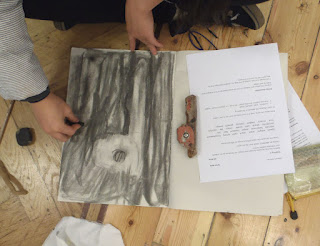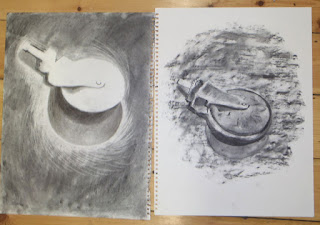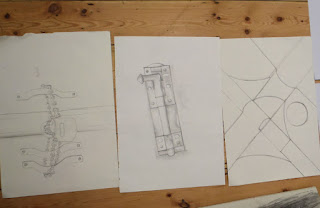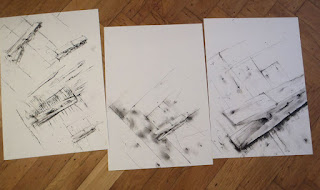Investigating observation, object and related space
As I would like everyone to approach this workshop with an open mind, it is my intention to keep the details to a minimum beforehand.
I will introduce the session with a short explanation of tasks 1 and 2. Task 3 will be described after completion of 1 and 2 to maintain the focus on object and observation and avoid any influence of mood. Meanwhile here is a quote from Keith Tyson discussing his drawing:
‘…it gives visual form to the invisible forces of physical world and universe: chaos and; atomic memory; the geometry, the wonder, the manifestation’.
Drawings in 1 and 2 are investigating observation, object and related space.
It is preferable to work from an object as a 2D photographic image (a secondary source) is limiting and alters the information available to draw on, however, it can be interesting as you have to work harder and possibly invent more.
- Materials - Drawing materials of your choice - Pens/ pencils or preferably charcoal as it’s a fluid medium that gives a more immediate response.
- A2/A3 paper - at least three sheets
- Working with Charcoal is quick, sensitive and messy. Mistakes can be knocked back and redrawn easily. Smudges and previous marks add to the information recorded and you can build form or structure through layers of light and dark tones.
HEALTH AND SAFETY - Spray fixative outside or in a well-ventilated area
2 or 3 quick analysis studies to explore your object/image and how it interrupts the space it’s in, think and respond with immediate decisions.
Let the object/ image lead your decisions- what is actually there? Look and quickly describe.
This is about seeing and finding information, and not about good drawing.
You can draw several images on the same sheet of paper, letting them overlap.
This is about seeing and finding information, and not about good drawing.
You can draw several images on the same sheet of paper, letting them overlap.
Move straight on to:
Drawing 2 40 mins
A longer study of your object/image using decisions made during the first drawing to motivate the starting point and your intention.
What interested you most? Choose one aspect you found that can direct this drawing.
Something about the quality, shape, texture or other interesting element will inform this longer study.
Something about the quality, shape, texture or other interesting element will inform this longer study.
How does it interrupt the space around it, considering that there is no solid outline?
As you draw think about the edges of object/image.
How does the space move around, over or through it, letting the outline explain?
Where is the centre of gravity?
Should it be thick /thin, solid or broken up or with gaps so lines can flow through or behind?
Drawing 3. 40 mins
Rethink drawing decisions through references I will introduce as you explore your individual subject further.
Choose an ABSTRACT NOUN from the list below, these are concepts that mean different things to different people.
Finally add definition and details. (carefully, to avoid smudging).
Speed weight scale silent calm empty temperature intimate loneliness anger freedom fear joy sensitivity peace pain power chaos life comfort love misery neglect melody growth energy
Think about the word, keep it in your mind but don’t let it over control.
It could influence the drawings character, becoming:
- confident, quiet, delicate, rough etc.
or - consider how you position it on the paper, large, small, should it touch 3 edges?


Group discussion
I will explain how this workshop will help my research and hope that the discussion will be useful to everyone through analysis of your personal response to the changes made at each stage of drawing.
My intention
in this workshop is to see how drawings alter when a student’s focus changes:
- drawings 1 and 2; working on a practical task, concentrating specifically on the object and how it’s edge interacts with the space. Responding with immediate decisions about the drawing and markmaking and avoiding over thinking mood or meaning.
- drawing 3; how does a word held in the mind influence the drawn image and markmaking qualities; and how does it reflect the atmosphere or message differently?
Evaluation
This workshop ran smoothly, timing and tasks were appropriate and students enjoyed the changes in focus.
All agreed the warm ups in task 1 helped define how to approach the longer drawings and the swap in focus for task 2 and 3 was interesting to complete.
A few comments
‘Charcoal is instant but not for a small drawing, the warm up drawings were needed.’
‘Mechanical – connects to industry, lovely design - this is what the object is about- really look at this object in an unusual way. You could live your whole lifetime and never really look at that object like that.’
‘Varying the outline interacts object with air around it, it becomes a working object, it explains its purpose, the role of the wheel, rotates.’
‘The site becomes more important, it unified things, both made from wood. The word added more about growth and scale.’
‘The word animates the drawing in a different way, it associates stuff to it.’
‘Fun of word, drawing becomes more abstracted taking it somewhere else.’
‘The word drawing was very different, thinking changed obviously, searching for something, it evolved from the object, I used an erasure to remove, emptying.’
‘Chains progression through three drawings until nothing is left but half a link, a very peaceful drawing.’
‘The erotic was there in the first warm ups, returned to and emphasised in drawing 3, it evolved.’
‘Line develops like a little aliens series, pushes through progression of drawings,
moving out of your comfort zone.’
‘The warm up drawing expresses freedom through its unfinished nature.’
Conclusion
When focusing on the specific task in 1 and 2, there remains an underlying influence or inherent ‘ness’1 evident in the individual drawings. Meaning is read through the relation of marks and compositional elements, often referenced instinctively (by wisdom and knowledge). A confident drawing expresses this meaning but does not overdo it. Introduction of the word affects intentions in drawing 3 and exaggerates the ‘ness’, emotional or other essence exposed in the drawing.
1. A word frequently used by Chelsea tutors.







No comments:
Post a Comment